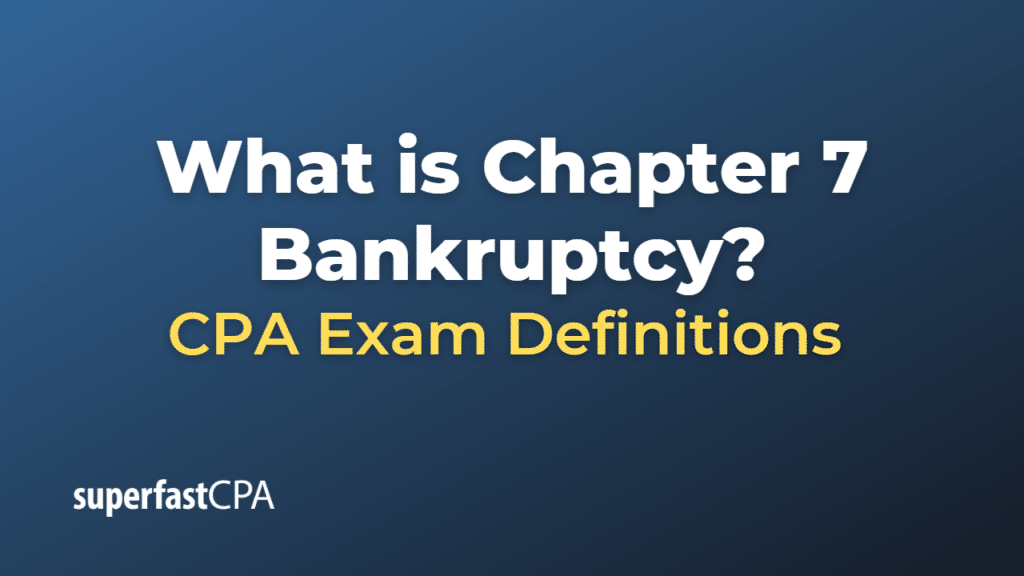Chapter 7 Bankruptcy
Chapter 7 bankruptcy, also known as “liquidation bankruptcy,” is a legal process in the United States that allows individuals and businesses to discharge their unsecured debts when they are unable to repay them. The primary purpose of Chapter 7 bankruptcy is to provide a fresh start for individuals or businesses facing overwhelming debt by eliminating most of their financial obligations.
In a Chapter 7 bankruptcy, the debtor’s non-exempt assets are sold, and the proceeds are distributed to the creditors. A court-appointed trustee oversees the liquidation process and ensures that the proceeds are distributed in accordance with the priority rules set forth in the bankruptcy code. Once the assets have been liquidated, and the proceeds have been distributed, most of the debtor’s remaining unsecured debts are discharged, meaning they are no longer legally required to be repaid.
Some key aspects of Chapter 7 bankruptcy include:
- Eligibility: To qualify for Chapter 7 bankruptcy, individuals must pass a “means test” that evaluates their income, expenses, and debt levels. The means test ensures that only those individuals who genuinely cannot repay their debts are allowed to file for Chapter 7 bankruptcy. Businesses do not need to pass a means test to file for Chapter 7 bankruptcy, but they must cease operations upon filing.
- Non-exempt assets: In a Chapter 7 bankruptcy, the debtor’s non-exempt assets are sold to repay creditors. Exempt assets, which vary by state, are protected and not subject to liquidation. These exemptions typically cover basic necessities, such as a primary residence, a modest vehicle, and personal items.
- Automatic stay: Once a debtor files for Chapter 7 bankruptcy, an automatic stay is put in place, which temporarily halts all collection efforts, lawsuits, and other actions by creditors to recover their debts.
- Discharge of debts: Most unsecured debts, such as credit card debt, personal loans, and medical bills, are discharged in a Chapter 7 bankruptcy. However, certain types of debt, like student loans, tax debts, and child support obligations, are typically not dischargeable.
It’s important to note that Chapter 7 bankruptcy has significant consequences, such as a negative impact on the debtor’s credit score and the potential loss of non-exempt assets. Therefore, individuals and businesses should carefully consider their options and consult with a bankruptcy attorney or financial advisor before deciding to file for Chapter 7 bankruptcy.
Example of Chapter 7 Bankruptcy
Let’s consider a hypothetical example of an individual filing for Chapter 7 bankruptcy:
John Doe is a single individual who has recently lost his job and is struggling to find new employment. Over the past few months, he has relied heavily on credit cards to cover his living expenses, resulting in $50,000 of credit card debt. In addition, he has $20,000 in outstanding medical bills from a recent health issue. John has come to the realization that he is unable to repay these debts, and his financial situation continues to worsen.
After consulting with a bankruptcy attorney, John decides to file for Chapter 7 bankruptcy, as it appears to be the best option to address his overwhelming debt.
- Eligibility: John takes the means test and, due to his current lack of income and the amount of his debt, he qualifies for Chapter 7 bankruptcy.
- Non-exempt assets: In John’s state, certain assets are exempt from liquidation, including his modest primary residence, an inexpensive car, and basic personal belongings. However, John owns a valuable collection of paintings that are considered non-exempt assets. The court-appointed trustee will sell these paintings to help pay off John’s creditors.
- Automatic stay: Upon filing for Chapter 7 bankruptcy, an automatic stay is put in place, temporarily stopping all collection efforts, lawsuits, and other actions by creditors to recover their debts. This gives John some relief from the constant calls and letters from his creditors.
- Liquidation and distribution: The trustee sells John’s collection of paintings and distributes the proceeds to his creditors according to the priority rules set forth in the bankruptcy code.
- Discharge of debts: After the liquidation process is complete, the court discharges most of John’s remaining unsecured debts, including his credit card debt and medical bills. John is no longer legally obligated to repay these debts.
While John’s credit score will be significantly impacted by the Chapter 7 bankruptcy, and it will remain on his credit report for up to 10 years, he now has the opportunity to rebuild his financial life without the burden of overwhelming debt.
This example illustrates how Chapter 7 bankruptcy can provide a fresh start for individuals facing insurmountable debt by discharging most of their financial obligations and allowing them to move forward with their lives.













